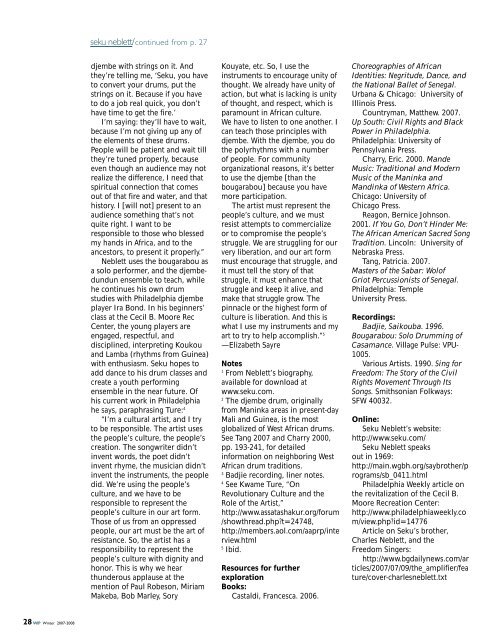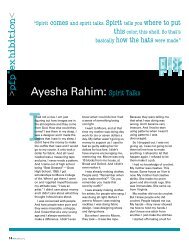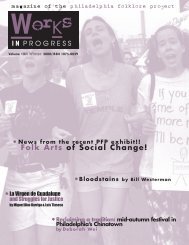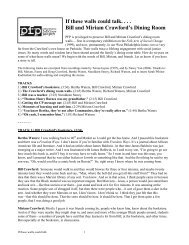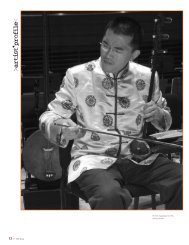African song / Fatu Gayflor ⢠War and wealth - Philadelphia Folklore ...
African song / Fatu Gayflor ⢠War and wealth - Philadelphia Folklore ...
African song / Fatu Gayflor ⢠War and wealth - Philadelphia Folklore ...
You also want an ePaper? Increase the reach of your titles
YUMPU automatically turns print PDFs into web optimized ePapers that Google loves.
seku neblett/continued from p. 27<br />
djembe with strings on it. And<br />
they’re telling me, ‘Seku, you have<br />
to convert your drums, put the<br />
strings on it. Because if you have<br />
to do a job real quick, you don’t<br />
have time to get the fire.’<br />
I’m saying: they’ll have to wait,<br />
because I’m not giving up any of<br />
the elements of these drums.<br />
People will be patient <strong>and</strong> wait till<br />
they’re tuned properly, because<br />
even though an audience may not<br />
realize the difference, I need that<br />
spiritual connection that comes<br />
out of that fire <strong>and</strong> water, <strong>and</strong> that<br />
history. I [will not] present to an<br />
audience something that’s not<br />
quite right. I want to be<br />
responsible to those who blessed<br />
my h<strong>and</strong>s in Africa, <strong>and</strong> to the<br />
ancestors, to present it properly.”<br />
Neblett uses the bougarabou as<br />
a solo performer, <strong>and</strong> the djembedundun<br />
ensemble to teach, while<br />
he continues his own drum<br />
studies with <strong>Philadelphia</strong> djembe<br />
player Ira Bond. In his beginners’<br />
class at the Cecil B. Moore Rec<br />
Center, the young players are<br />
engaged, respectful, <strong>and</strong><br />
disciplined, interpreting Koukou<br />
<strong>and</strong> Lamba (rhythms from Guinea)<br />
with enthusiasm. Seku hopes to<br />
add dance to his drum classes <strong>and</strong><br />
create a youth performing<br />
ensemble in the near future. Of<br />
his current work in <strong>Philadelphia</strong><br />
he says, paraphrasing Ture: 4<br />
“I’m a cultural artist, <strong>and</strong> I try<br />
to be responsible. The artist uses<br />
the people’s culture, the people’s<br />
creation. The <strong>song</strong>writer didn’t<br />
invent words, the poet didn’t<br />
invent rhyme, the musician didn’t<br />
invent the instruments, the people<br />
did. We’re using the people’s<br />
culture, <strong>and</strong> we have to be<br />
responsible to represent the<br />
people’s culture in our art form.<br />
Those of us from an oppressed<br />
people, our art must be the art of<br />
resistance. So, the artist has a<br />
responsibility to represent the<br />
people’s culture with dignity <strong>and</strong><br />
honor. This is why we hear<br />
thunderous applause at the<br />
mention of Paul Robeson, Miriam<br />
Makeba, Bob Marley, Sory<br />
Kouyate, etc. So, I use the<br />
instruments to encourage unity of<br />
thought. We already have unity of<br />
action, but what is lacking is unity<br />
of thought, <strong>and</strong> respect, which is<br />
paramount in <strong>African</strong> culture.<br />
We have to listen to one another. I<br />
can teach those principles with<br />
djembe. With the djembe, you do<br />
the polyrhythms with a number<br />
of people. For community<br />
organizational reasons, it’s better<br />
to use the djembe [than the<br />
bougarabou] because you have<br />
more participation.<br />
The artist must represent the<br />
people’s culture, <strong>and</strong> we must<br />
resist attempts to commercialize<br />
or to compromise the people’s<br />
struggle. We are struggling for our<br />
very liberation, <strong>and</strong> our art form<br />
must encourage that struggle, <strong>and</strong><br />
it must tell the story of that<br />
struggle, it must enhance that<br />
struggle <strong>and</strong> keep it alive, <strong>and</strong><br />
make that struggle grow. The<br />
pinnacle or the highest form of<br />
culture is liberation. And this is<br />
what I use my instruments <strong>and</strong> my<br />
art to try to help accomplish.” 5<br />
—Elizabeth Sayre<br />
Notes<br />
1<br />
From Neblett’s biography,<br />
available for download at<br />
www.seku.com.<br />
2<br />
The djembe drum, originally<br />
from Maninka areas in present-day<br />
Mali <strong>and</strong> Guinea, is the most<br />
globalized of West <strong>African</strong> drums.<br />
See Tang 2007 <strong>and</strong> Charry 2000,<br />
pp. 193-241, for detailed<br />
information on neighboring West<br />
<strong>African</strong> drum traditions.<br />
3<br />
Badjie recording, liner notes.<br />
4<br />
See Kwame Ture, “On<br />
Revolutionary Culture <strong>and</strong> the<br />
Role of the Artist,”<br />
http://www.assatashakur.org/forum<br />
/showthread.php?t=24748,<br />
http://members.aol.com/aaprp/inte<br />
rview.html<br />
5<br />
Ibid.<br />
Resources for further<br />
exploration<br />
Books:<br />
Castaldi, Francesca. 2006.<br />
Choreographies of <strong>African</strong><br />
Identities: Negritude, Dance, <strong>and</strong><br />
the National Ballet of Senegal.<br />
Urbana & Chicago: University of<br />
Illinois Press.<br />
Countryman, Matthew. 2007.<br />
Up South: Civil Rights <strong>and</strong> Black<br />
Power in <strong>Philadelphia</strong>.<br />
<strong>Philadelphia</strong>: University of<br />
Pennsylvania Press.<br />
Charry, Eric. 2000. M<strong>and</strong>e<br />
Music: Traditional <strong>and</strong> Modern<br />
Music of the Maninka <strong>and</strong><br />
M<strong>and</strong>inka of Western Africa.<br />
Chicago: University of<br />
Chicago Press.<br />
Reagon, Bernice Johnson.<br />
2001. If You Go, Don’t Hinder Me:<br />
The <strong>African</strong> American Sacred Song<br />
Tradition. Lincoln: University of<br />
Nebraska Press.<br />
Tang, Patricia. 2007.<br />
Masters of the Sabar: Wolof<br />
Griot Percussionists of Senegal.<br />
<strong>Philadelphia</strong>: Temple<br />
University Press.<br />
Recordings:<br />
Badjie, Saikouba. 1996.<br />
Bougarabou: Solo Drumming of<br />
Casamance. Village Pulse: VPU-<br />
1005.<br />
Various Artists. 1990. Sing for<br />
Freedom: The Story of the Civil<br />
Rights Movement Through Its<br />
Songs. Smithsonian Folkways:<br />
SFW 40032.<br />
Online:<br />
Seku Neblett’s website:<br />
http://www.seku.com/<br />
Seku Neblett speaks<br />
out in 1969:<br />
http://main.wgbh.org/saybrother/p<br />
rograms/sb_0411.html<br />
<strong>Philadelphia</strong> Weekly article on<br />
the revitalization of the Cecil B.<br />
Moore Recreation Center:<br />
http://www.philadelphiaweekly.co<br />
m/view.php?id=14776<br />
Article on Seku’s brother,<br />
Charles Neblett, <strong>and</strong> the<br />
Freedom Singers:<br />
http://www.bgdailynews.com/ar<br />
ticles/2007/07/09/the_amplifier/fea<br />
ture/cover-charlesneblett.txt<br />
28 WIP Winter 2007-2008


